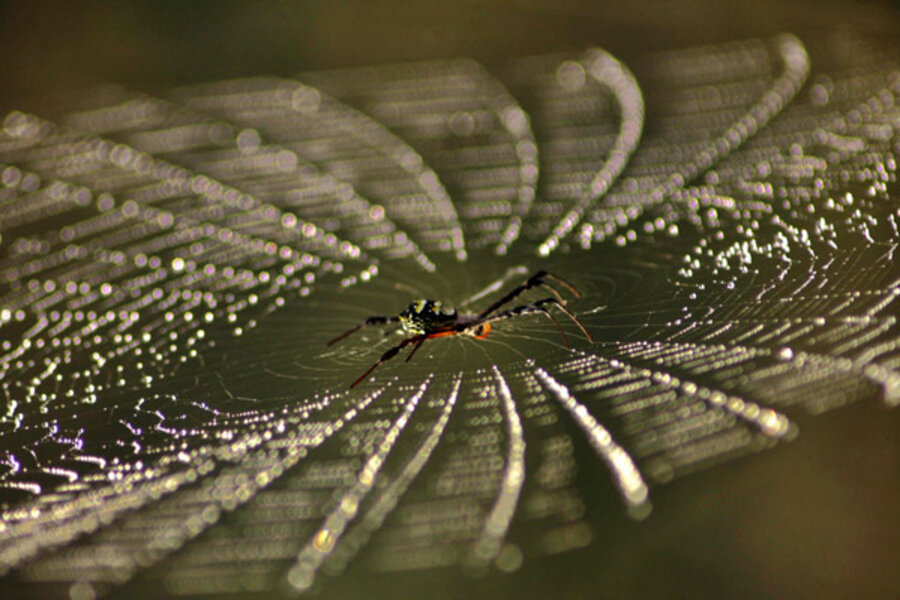Can a spider web hold clues for better buildings? Science takes a step.
Loading...
Call it silk envy.
For years, engineers and materials scientists have marveled at the strength that spider silk displays – topping that of steel. And they've marveled at the design and hardiness of spider webs.
Now, a research team has discovered how the silk responds to stress – a response unlike that in any material humans have engineered. The results will appear in the Thursday issue of the journal Nature.
In essence, when pressure is applied, the silk first stiffens. As pressure increases, it stretches, only to stiffen again as the pressure reaches the silk's breaking point.
These traits help explain why damage to a spider web from daily use remains local, preserving the integrity of the web as a whole, the researchers say.
It's an explanation with potential benefits for human engineering, says Markus Buehler, an associate professor of engineering at the Massachusetts Institute of Technology in Cambridge, who led the research team. Indeed, the information gleaned could help humans take advantage of unique-but-hard-to-work-with building blocks for new materials, such as carbon nanotubes.
“These are superb materials” at scales of billionths of a meter, Dr. Buehler says. “People got Nobel Prizes for this."
But so far, adapting nanotubes to human-scale projects has proved difficult. "If you want to actually use these [materials] to make a car or a coating or a building, it doesn't work because we lose all the strength” exhibited by the pint-size samples, Buehler says.
But the new analysis of spider silk could allow materials scientists to use such building blocks to craft materials that take full advantage, on human scales, of desirable properties that once appeared only at nanometer sizes.
In demonstrating how the silk contributes to the hardiness of the network of strands that make up a web, Buehler says, the results eventually could help engineers craft power grids, data networks, and even buildings to survive natural or human assaults with minimal damage.
Spiders have had some 400 million years of evolutionary history to hone their chemistry and engineering tools, notes Jessica Garb, an ecologist at the University of Massachusetts at Lowell who is studying the genetics behind spider silks and venoms.
Developing the ability to excrete a silk thread that responds differently to different levels of stress comes from trial and error through random genetic mutations within spider populations, she says.
“It's hard to make a living as a spider,” says Dr. Garb. “It's not like there's a constant stream of prey. A lot of times they're waiting for something,” and snagging it “is a matter of life or death.”
Spiders with slight genetic mutations that generated a mix of proteins that built the silk best suited for webs capturing the most prey survived to keep the evolutionary wheels turning. Those that didn't have most effective mix for web building vanished.
As part of this process, spiders have developed an array of silk types. Single spiders are capable of producing several types – from structural silks; to sticky, prey-snagging strands; to glues that fasten a web's main structural threads to bush branches or barn beams.
Scientists have identified more than 40,000 spider species and suspect that thousands more await discovery, Garb says.
For its study, Buehler's team selected orb-weaver spiders – including about 25 percent of all known spider species. The webs are roughly circular, with spokes. They're filled in with threads that spiral out from the hub. The spoke-like strands are the strongest. The spirals are weaker and coated with a sticky adhesive to trap insects.
Enough is known about the biochemistry of silk formation among orb weavers that Buehler's team could use a detailed computer model to produce virtual silk threads, starting with the amino acids that make up the proteins involved. Then the team used the model to explore the silks' properties and gauge their contributions to a web's robustness.
Materials that humans engineer – from rubber to steel – tend to grow increasingly stiff until they break – or they grow increasingly pliable under increasing stress, Buehler explains. But the modeling was what revealed that the silk threads forming the spokes had the ability to stiffen, stretch, then stiffen again as stress was added.
This means a spider – whose meals are few and far between – has to spend less energy maintaining a web. A spiral thread might break as a flying insect collides with it, but the damage is limited to the span between spokes. If the winged bug hits a spoke, a main structural element, the silk thread yields before stiffening again and breaking. This reduces the shock of impact on other spokes and allows them to hold the web together.
Either way, the damage is limited to the area immediately around the point of impact. In effect, the spider has an ability to build a web in which it's possible to sacrifice a portion without compromising the whole network.
After running the computer simulations, team members tested the results by heading into the field to pluck at spider webs – no doubt to the great frustration of the arachnids that built them. Sure enough, the real webs behaved as the models foretold.
The marvel, Buehler says, is that the silk is made at ambient temperatures inside a spider from simple building blocks whose ability to bond to one another is so weak that engineers would never consider using them for human-scale applications.
“Yet if you look at the system with engineering tools, it's absolutely stunning,” he says – a case of the whole being greater than the sum of the parts. “We don't have anything like this. Yet a spider makes this on the fly.”







